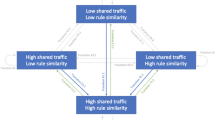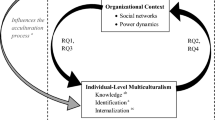Abstract
This paper considers a formal model of cultural transmission in organizations, examining the interplay of structured social influence and organizational demography. A set of focused and fine-grained computational experiments elucidates this model’s assumptions, facilitates deeper explanations for some of its behavior, and explores the robustness and scope conditions of previously published conclusions. In doing so, this investigation highlights several important issues in the design and evaluation of computational experiments.
Similar content being viewed by others
Explore related subjects
Discover the latest articles and news from researchers in related subjects, suggested using machine learning.References
Axelrod R (1997) The dissemination of culture: a model with local convergence and global polarization. In: Axelrod R (ed) The complexity of cooperation. Princeton University Press, Princeton, pp 148–177
Axtell R, Axelrod R, Epstein JM, Cohen MD (1996) Aligning simulation models: a case study and results. Comput Math Organ Theory 1:123–141
Carley K (1991) A theory of group stability. Am Sociol Rev 56:331–354
Carroll GR, Harrison JR (1998) Organizational demography and culture: insights from a formal model and simulation. Adm Sci Q 43:637–667
Epstein JM, Axtell R (1996) Growing artificial societies: social science from the bottom up. MIT Press, Cambridge
Fararo TJ, Butts CT (1999) Advances in generative structuralism: structured agency and multilevel dynamics. J Math Sociol 24:1–65
Friedkin NE, Johnsen EC (1990) Social influence and opinions. J Math Sociol 15:193–206
Granovetter MS (1973) The strength of weak ties. Am J Sociol 78:1360–1380
Harrison JR, Carroll GR (1991) Keeping the faith: a model of cultural transmission in formal organizations. Adm Sci Q 36:552–582
Harrison JR, Carroll GR (2001a) Modeling organizational culture: demography and influence networks. In: Cooper CL, Cartwright S, Earley PC (eds) The international handbook of organizational culture and climate. Wiley, New York, pp 185–216
Harrison JR, Carroll GR (2001b) Modeling culture in organizations: formulation and extension to ecological issues. In Lomi A, Larsen ER (eds) Dynamics of organizations: computational modeling and organization theories. AAAI Press, Menlo Park, pp 37–62
Harrison JR, Carroll GR (2002) The dynamics of cultural influence networks. Comput Math Organ Theory 8:5–30
Harrison JR, Carroll GR (2006) Culture and demography in organizations. Princeton University Press, Princeton
Kitts JA (2006) Collective action, rival incentives, and the emergence of antisocial norms. Am Sociol Rev 71:235–259
Kitts JA (2007) Bailing out: an elementary model of disaffiliation. Unpublished
Krackhardt D (2001) Viscosity models and the diffusion of controversial innovations. In: Lomi A, Larsen R (eds) Dynamics of organizations. MIT Press, pp 243–268
Latané B (1996) Dynamic social impact: the creation of culture by communication. J Commun 46:13–25
Latane B (2000) Pressures to uniformity and the evolution of cultural norms. In: Ilgen DR, Hulin CL (eds) Computational modeling of behavior in organizations: the third scientific discipline, pp 189–215
Lazarsfeld PF, Merton RK (1954) Friendship as a social process: a substantive and methodological analysis. In: Berger M, Abel T, Page CH (eds) Freedom and control in modern society. Van Nostrand, New York, pp 8–66
Macy MW, Kitts JA, Flache A (2003) Polarization in dynamic networks: a Hopfield model of emergent structure. In: Dynamic social network modeling and analysis. National Academies, Washington
Mark N (1998) Beyond individual differences: social differentiation from first principles. Am Sociol Rev 63:309–330
Author information
Authors and Affiliations
Corresponding author
Rights and permissions
About this article
Cite this article
Kitts, J.A., Trowbridge, P.T. Shape up or ship out: social networks, turnover, and organizational culture. Comput Math Organiz Theor 13, 333–353 (2007). https://doi.org/10.1007/s10588-007-9015-x
Published:
Issue Date:
DOI: https://doi.org/10.1007/s10588-007-9015-x




